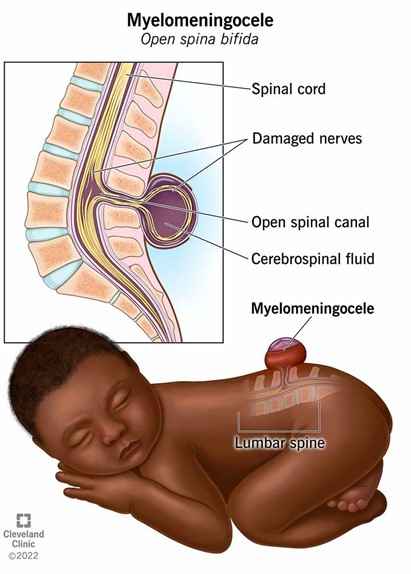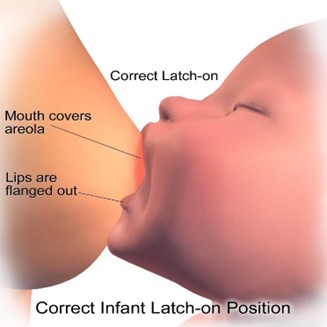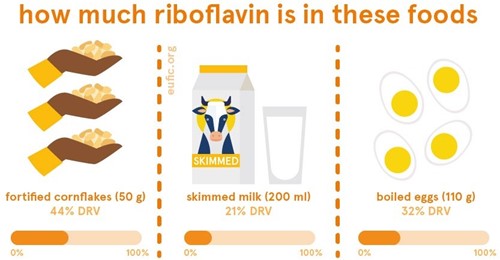A nurse is planning care immediately following birth for a newborn who has a myelomeningocele that is leaking cerebrospinal fluid. Which of the following actions should the nurse include in the plan of care?
Cleanse the site with povidone-iodine.
Administer broad-spectrum antibiotics.
Prepare for surgical closure after 72 hours.
Monitor the rectal temperature every 4 hours.
The Correct Answer is B
A. Using povidone-iodine on the site of a myelomeningocele is not recommended as it can be irritating to the tissue and might not be safe for use on open neural tissue. The focus should be on preventing infection through other means.
B. Administering broad-spectrum antibiotics is crucial as the cerebrospinal fluid (CSF) leak increases the risk of infection, such as meningitis. Antibiotics help protect the newborn from potentially serious infections until surgical repair can be performed.
C. Surgical closure of a myelomeningocele is typically done as soon as possible, often within 24-48 hours after birth, to minimize the risk of infection and further damage to the exposed spinal cord.
D. While monitoring temperature is important, rectal temperature measurement is not recommended for a newborn with a myelomeningocele due to the risk of causing further complications. Axillary temperature measurement would be safer and less invasive.

Nursing Test Bank
Naxlex Comprehensive Predictor Exams
Related Questions
Correct Answer is D
Explanation
Sore nipples are a common problem for breastfeeding mothers, especially in the first few days or weeks after delivery. They can cause pain, discomfort, and frustration, and may interfere with breastfeeding success and satisfaction. The most common cause of sore nipples is poor latch, which means that the newborn does not attach to the breast correctly and does not suckle effectively. Poor latch can result from various factors, such as improper positioning, tongue-tie, inverted or flat nipples, engorgement, or thrush.
The nurse should assess the newborn's latch while breastfeeding to identify and correct any problems that may cause sore nipples. The nurse should observe the following signs of a good latch:
- The newborn's mouth is wide open and covers most of the areola (the dark area around the nipple).
- The newborn's chin and nose touch the breast, and the cheeks are rounded and not dimpled.
- The newborn's tongue is visible under the lower lip and curls around the breast.
- The newborn's lips are flanged outwards and not tucked inwards.
- The newborn's jaw moves rhythmically and smoothly, and swallowing sounds are audible.
- The mother feels a gentle tugging sensation on the nipple, but no pain or pinching.
The nurse should also teach the mother how to achieve a good latch by using different positions, supporting the breast with her hand, tickling the newborn's lower lip with her nipple, and bringing the newborn to the breast when their mouth is wide open. The nurse should also encourage the mother to seek help from a lactation consultant or a peer support group if she has persistent or severe nipple pain.
a) Instructing the client to wait 4 hours between daytime feedings is not an appropriate action for the nurse to take. This may reduce nipple soreness temporarily, but it can also cause breast engorgement, milk supply reduction, mastitis, or poor weight gain in the newborn. The nurse should advise the client to feed the newborn on demand, usually every 1.5 to 3 hours during the day and every 3 to 4 hours at night.
b) Offering supplemental formula between the newborn's feedings is not an appropriate action for the nurse to take. This may interfere with breastfeeding initiation and establishment, as it can reduce the mother's milk supply, confuse the newborn's sucking pattern, increase the risk of nipple preference or rejection, and expose the newborn to potential allergens or infections. The nurse should support exclusive breastfeeding for the first six months of life, unless there is a medical indication for supplementation.
c) Having the client limit the length of breastfeeding to 5 minutes per breast is not an appropriate action for the nurse to take. This may not be enough time for the newborn to get enough milk, especially the hindmilk that is richer in fat and calories. It may also prevent proper drainage of the breast and lead to engorgement or mastitis. The nurse should advise the client to let the newborn feed until they are satisfied and release the breast on their own, which may take 10 to 20 minutes per breast on average.

Correct Answer is D
Explanation
This is the food that the nurse should recommend to the client who practices a vegan diet and is trying to increase intake of vitamin B2. Vitamin B2, also known as riboflavin, is an essential nutrient that is involved in energy metabolism, growth, and cell function¹. It is found in small amounts in a variety of plant foods, such as avocados, mushrooms, almonds, leafy green vegetables, and soybeans³. However, some of the best sources of riboflavin are animal products, such as dairy products and eggs¹. Therefore, vegans may need to consume fortified foods or supplements to meet their daily requirements of riboflavin.
Fortified soy milk is a good option for vegans because it contains added riboflavin, as well as other nutrients such as calcium, vitamin B12, and vitamin D. One cup of fortified soy milk can provide about 0.5 milligrams of riboflavin, which is about 45% of the recommended daily amount for women and 38% for men⁴. Other fortified vegan foods that may contain riboflavin include breakfast cereals, nutritional yeast, and plant- based meat alternatives²⁵.
The other options are not correct because they are not good sources of riboflavin.
a) Raw carrots
Raw carrots are a healthy vegetable that provide vitamin A, fiber, and antioxidants. However, they are not a good source of riboflavin. One medium carrot contains only 0.02 milligrams of riboflavin, which is less than 2% of the recommended daily amount⁴.
b) Fresh citrus fruits
Fresh citrus fruits are a great source of vitamin C, folate, and potassium. However, they are not a good source of riboflavin. One medium orange contains only 0.04 milligrams of riboflavin, which is about 4% of the recommended daily amount⁴.
c) Brown rice
Brown rice is a whole grain that provides complex carbohydrates, fiber, and minerals. However, it is not a good source of riboflavin. One cup of cooked brown rice contains only 0.05 milligrams of riboflavin, which is about 5% of the recommended daily amount⁴.

Whether you are a student looking to ace your exams or a practicing nurse seeking to enhance your expertise , our nursing education contents will empower you with the confidence and competence to make a difference in the lives of patients and become a respected leader in the healthcare field.
Visit Naxlex, invest in your future and unlock endless possibilities with our unparalleled nursing education contents today
Report Wrong Answer on the Current Question
Do you disagree with the answer? If yes, what is your expected answer? Explain.
Kindly be descriptive with the issue you are facing.
